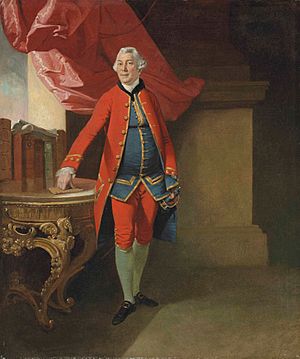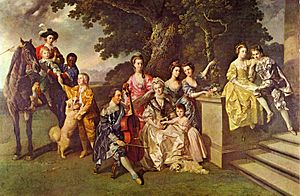Sir William Young, 1st Baronet, of North Dean facts for kids
Quick facts for kids
Sir William Young, 1st Baronet
|
|
|---|---|

Portrait of Sir William Young, 1st Baronet painted by Agostino Brunias, 1770
|
|
| Born | 1724 |
| Died | 1788 (aged 63–64) |
| Occupation | Governor of Dominica |
Sir William Young, 1st Baronet (1725 – 1788) was an important politician and plantation owner born in Antigua. He was in charge of a special group that sold land in new British colonies. Later, he became the very first non-military governor of Dominica in 1768.
Contents
Early Life and Beginnings
Sir William Young was born in Antigua in 1725. His father, Dr. William Young, had moved there from Scotland. This happened after a big event called the Jacobite uprising in 1715.
What Did Sir William Young Do?
Sir William Young was a very smart person. In 1748, he became a Fellow of the Royal Society. This is a group for important scientists and thinkers. His friends said he knew a lot about science and was always ready to help new ideas.
He also wrote a book in 1764. It was about how to help new British colonies in the West Indies grow and succeed.
Leading the New Colonies
In 1764, the Prime Minister, George Grenville, chose Sir William Young for a big job. He was put in charge of selling land in islands that Britain had just won from France. These islands included Grenada, Tobago, Dominica, and St Vincent. Britain got these islands after the 1763 Peace of Paris treaty.
Building Model Colonies
Sir William Young's group had a special goal. They wanted to create perfect colonies. They aimed to learn from other successful places. But they also wanted to avoid problems like worn-out land and harm to nature.
He spent eight years away from his family, from 1764 to 1773. During this time, he traveled a lot between the islands. He even hired an artist named Agostino Brunias. This artist drew pictures of the places Sir William Young visited and the work his group was doing. Sir William Young also kept a diary and drew his own pictures. He wrote about 110 trips he made to the islands.
Governor of Dominica
In 1768, Sir William Young became the Lieutenant Governor of Dominica. Then, in 1769, he was given the special title of Baronet. This meant he was called "Sir William Young of North Dean."
Becoming the First Governor
On November 17, 1770, he became the first official Governor of Dominica. He helped build important places in Roseau, Dominica's main town. One was Fort Young, which was a military fort. Today, it is a hotel. He also built Government House, Dominica, which was his home near the fort.
He left Dominica in 1772. He quickly went to St Vincent to help with a conflict called the "Carib War." He also wanted to protect his own properties there. By the end of 1773, Sir William Young was back in England. His job as Governor ended. His family felt that his time in the new islands had cost him a lot of money.
Family Life
Sir William Young had several children with his second wife, Elizabeth. She was the daughter of a famous mathematician, Brook Taylor. Their children included Sarah Elizabeth, William, Portia, Elizabeth, Mary, Henry, John, and Olivia.
An artist named Johann Zoffany painted a famous picture of Sir William Young and ten of his family members. His oldest son, Sir William Young, 2nd Baronet (1749–1815), also became a governor. He was the Governor of Tobago from 1807 to 1815. He was also a Member of Parliament.
Financial Challenges
Sir William Young bought some of the best land in Antigua, St Vincent, and Tobago. But he still had many debts. When he passed away in 1788, he left a debt of about £110,000. This was a huge amount of money for his son to pay off. His son also inherited four large farms and many enslaved people. Sadly, he could not save them from financial trouble.
Legacy
Young Island in the Grenadines is named after Sir William Young.
See also



